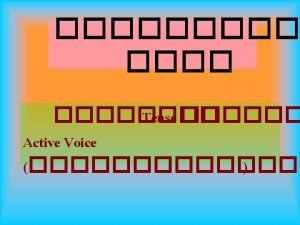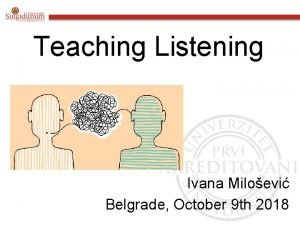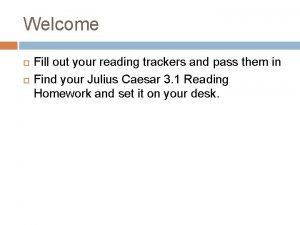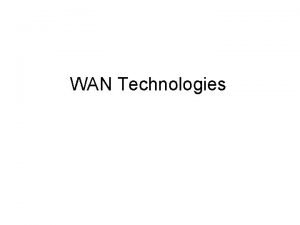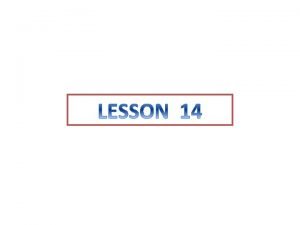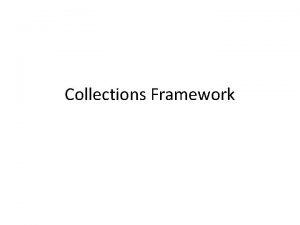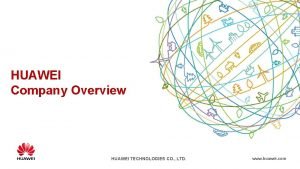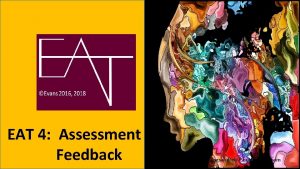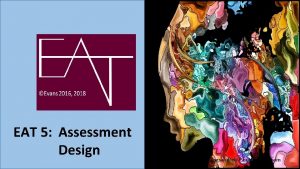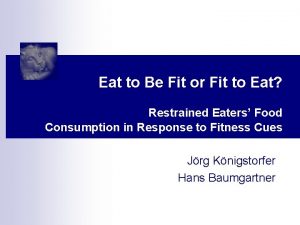EAT 1 Overview agsandrewShutterstock com EAT is a



















- Slides: 19

EAT 1: Overview © agsandrew/Shutterstock. com

EAT is a research-informed integrative assessment framework that helps you to consider all aspects of assessment practice and the interrelationships between them with colleagues and students.

Importance of assessment as an individual and collective process that considers individual and organisational facilitators and barriers

EAT Promotes: Equity Agency Transparency In assessment

Underpinning premise of EAT: How students come to co-own their programmes with lecturers and see themselves as active contributors to the assessment feedback process rather than seeing assessment as something that is done to them (EAT, 2016)

EAT Dimensions It comprises 12 inter-related areas related to Assessment Literacy Assessment Feedback Assessment Design


The EAT Framework origins: Making sense of assessment and feedback: A research-informed approach http: //journals. sagepub. com/doi/abs/10. 3102/0034654312 474350

The literature base informing EAT Cognitive styles 2013 Systematic Review of 700 articles selected from >9000 2015 Waring and Evans Understanding Pedagogy 2014 Kozhevnikov, Evans & Kosslyn Neuroscience/cognitive & educational psychology 2013 Making Sense of Assessment Feedback Systematic Review of 460 articles from >4000 articles Emotions in learning Maximising Success of Assessment Systematic Review of 1100 articles from > 12, 000 2015 High Impact Pedagogies and Student Engagement Systematic Review of 21, 055 abstracts and selection and analysis of 1671 Detailed analysis of 273 articles Resilience 2016 -20 EAT Deep approaches to learning Teaching styles Assessment and selfregulation 2018 Additional 1000 articles selected from > 10, 000 9

Informed by a Personal Learning Styles Pedagogy Beliefs and Values Use of appropriate tools to support learning Optimising conditions for learning/ sensitivity to learner context Design of learning environments to maximize self-regulatory development Supporting leaner autonomy: choices in learning / student voice (Waring and Evans, 2015) 10

PLSP A Beliefs and Values B. Appropriate Tools C. Sensitivity to Context D. Self-regulatory Design E. Learner Autonomy

ALL ABOUT DESIGN Greater emphasis should be placed on assessment designs that promote student engagement with all dimensions of the assessment process as part of ‘knowing to’ (Sadler, 2013)

13

14

EAT 1 Questions 1. In reviewing your own assessment design, which areas of EAT are most in need of development? 2. As a team are you agreed on priorities for development? 3. Are there specific modules that require attention? 4. What are your students’ EAT profiles? Is it possible to identify ‘tribes’ with similar initial profiles and undertake a needs analysis of specific groups? 5. Having inducted students’ into their role within assessment, to what extent have students’ EAT profiles evolved? 6. What practices have been most effective in supporting student engagement with assessment? © agsandrew/Shutterstock. com

Waring, M. , & Evans, C. (2015). Understanding Pedagogy: Developing a Critical Approach to Teaching and Learning. Abingdon, Oxford, United Kingdom: Routledge. http: //www. amazon. co. uk/Understan ding-Pedagogy-Developing-criticalapproach/dp/041557174 X This book provides overview of the Personal Learning Styles Pedagogy and theories underpinning it and how you can use the core ideas in practice. It informed the development of the EAT Framework



 Bài thơ mẹ đi làm từ sáng sớm
Bài thơ mẹ đi làm từ sáng sớm Cơm
Cơm I eat you eat he eats
I eat you eat he eats People buy me to eat
People buy me to eat I would rather eat potatoes than to eat rice.
I would rather eat potatoes than to eat rice. The odyssey overview
The odyssey overview Citibank culture
Citibank culture Client devices portfolio overview
Client devices portfolio overview Background and thesis statement
Background and thesis statement Wan technologies atm
Wan technologies atm Followpos
Followpos Java collections overview
Java collections overview Project management overview
Project management overview Safe overview
Safe overview Spring framework overview
Spring framework overview Real time interaction management forrester
Real time interaction management forrester Huawei company introduction
Huawei company introduction Sophocles greek tragedy
Sophocles greek tragedy Walmart operations
Walmart operations An overview of money
An overview of money


